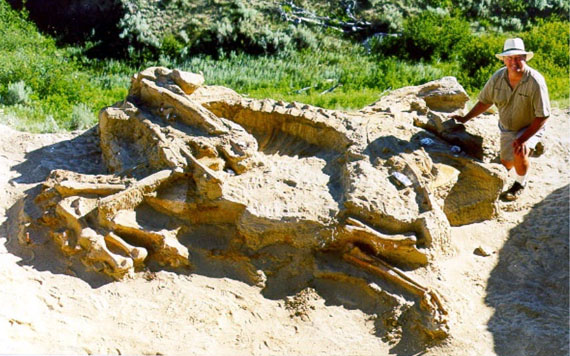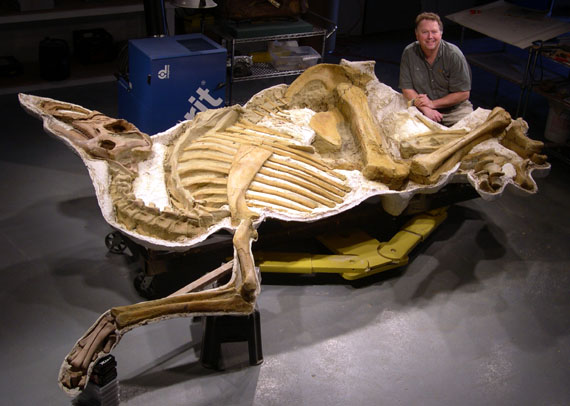|
Paleontologists Hit Jackpot near Malta,
Montana 
Photos courtesy of
Judith River Dinosaur Institute in Malta,
Montana
Since the mid-nineties, several world-class
duckbilled dinosaurs have been discovered in
the Malta area. Duckbilled dinosaurs
(hadrosaurs) are named for their duckbill-like
lips that were used to strip leaves off of
branches. There are several types, including
the Maiasaura (good mother lizard)
discovered at Egg Mountain near
Choteau in 1979. The duckbilled dinosaurs
discovered in the Malta area are a type called
Brachylophosaura.
1. The first discovery, called “Elvis”, is now on
display at the Phillips County Museum on
Highway #2 in Malta. Elvis was discoved in
1992 by Nate Murphy, the Phillips County
Museum's Curator of Paleontology. The
32-foot brachylophosaurus was given the
name Elvis because of its "pristine pelvis".
2. The second dinosaur (shown in the photo
above and below), called “Roberta”, is
currently at the “Dinosaur Field Station’ just
down the street from the museum. The field
station is a lab where the specimens are
prepared for display and/or molding. By
making molds of the bones, replicas can be
produced for viewing in several museums.
Scientists think that Roberta may have died as
a resault of a broken jaw that became
infected.
3. Although both Elvis and Roberta are terrific
specimens, the third dinosaur discovery has
been stealing the spotlight. “Leonardo, the
Mummy Dinosaur” is one of only four dinosaur
specimens in the world with fossilized skin
and muscle. When the young dinosaur died
77 million years ago, rare natural conditions
combined to preserve its soft tissues in great
detail, including its stomach contents! In fact
pollen from its digestive tract tell what it ate in
its last days. Leonardo’s tendons, muscles,
and skin were naturally preserved and
mineralized unlike other fossils whose softer
tissues decompose before turning to stone.
Some scientists are calling Leonardo "the
fossil find of the century" and it is now
recognized by Guiness as the "world's best
preserved dinosaur". Like Roberta,
Leonardo can be viewed at the field station
where a
guided tour costs $5.
4. The forth discovery, a “baby dinosaur” called
“Peanut” was also brought to the field station
last summer.
All of the Phillips County dinosaurs were
excavated by the Judith River Dinosaur
Institute, which is supported by the Judith
River Foundation. The non-profit foundation
was established by Nate Murphy in 2002 to
recover, prepare,
and display local dinosaur treasures. If it
weren’t for the efforts of
Murphy (shown in photos) and the foundation,
it is likely that the
dinosaurs found in this area would have
ended up in museums far from Malta. Instead
their presence will certainly provide a boost to
the economy of this the small Hi-Line
community. The Foundation is named for the
Judith River Formation, a series of rock layers
deposited over 65 million years ago near the
edge of a shallow sea that inundated the
Great Plains.
An Unfortunate Turn of Events: Update May 2009 . . .
Unfortunately Nate Murphy is no longer associated with the Judith River Dinosaur Institute. In May of 2009 he was sentenced to to jail (60 days) for stealing a raptor fossil from private land in the Malta area. Sentencing in a separate federal case involving Murphy's theft of several more fossils is scheduled for later this summer (in July 2009). The lesson to be learned here is that fossils found on private land belong to the land owner, those found on federal land (BLM, National Forrest, etc.) belong to the federal government, and those found on state land belong to the state of Montana.
Nate Murphy with Roberta in the
"field station"
Update: The June 27, 2005 issue of Newsweek featured a great story about Montana's wealth of dinosaur finds, inlcuding quite a bit about the work of Nate Murphy in the Malta area. Terms: paleontology, curator
|





